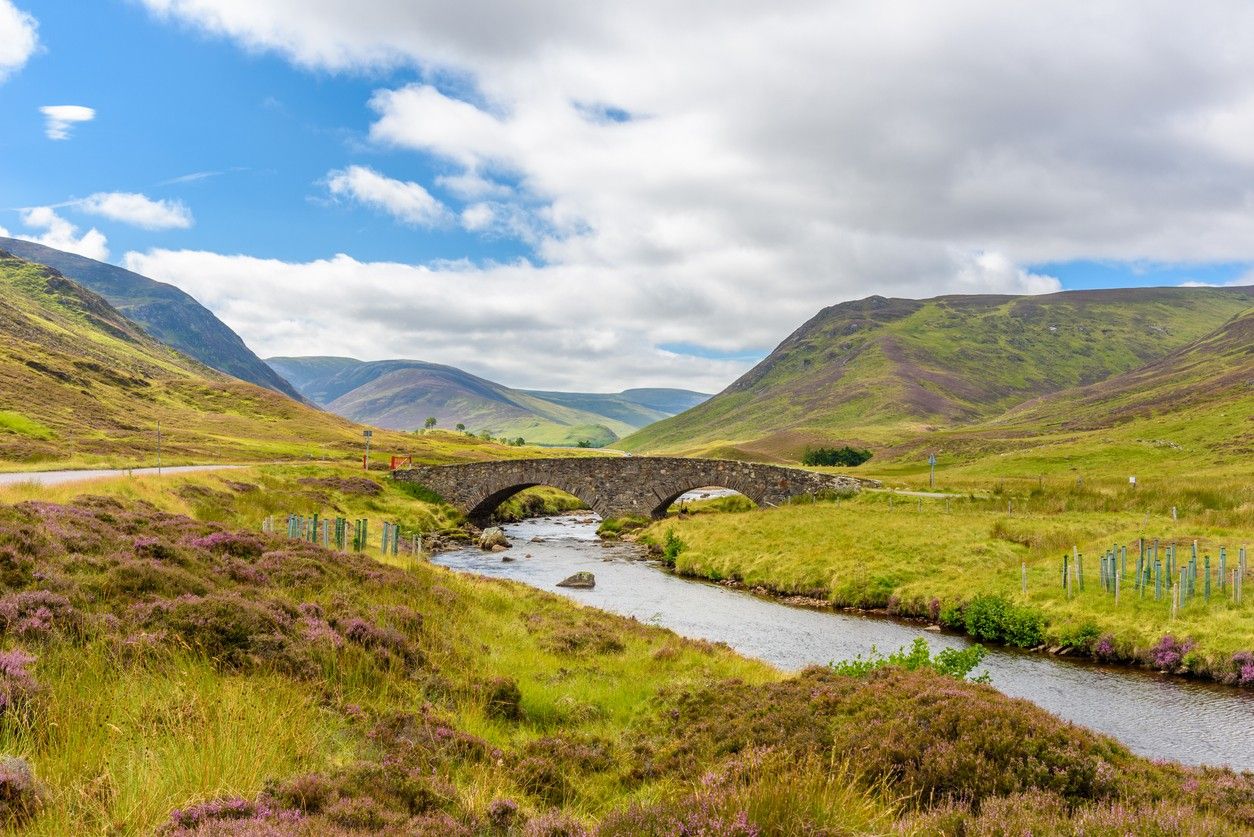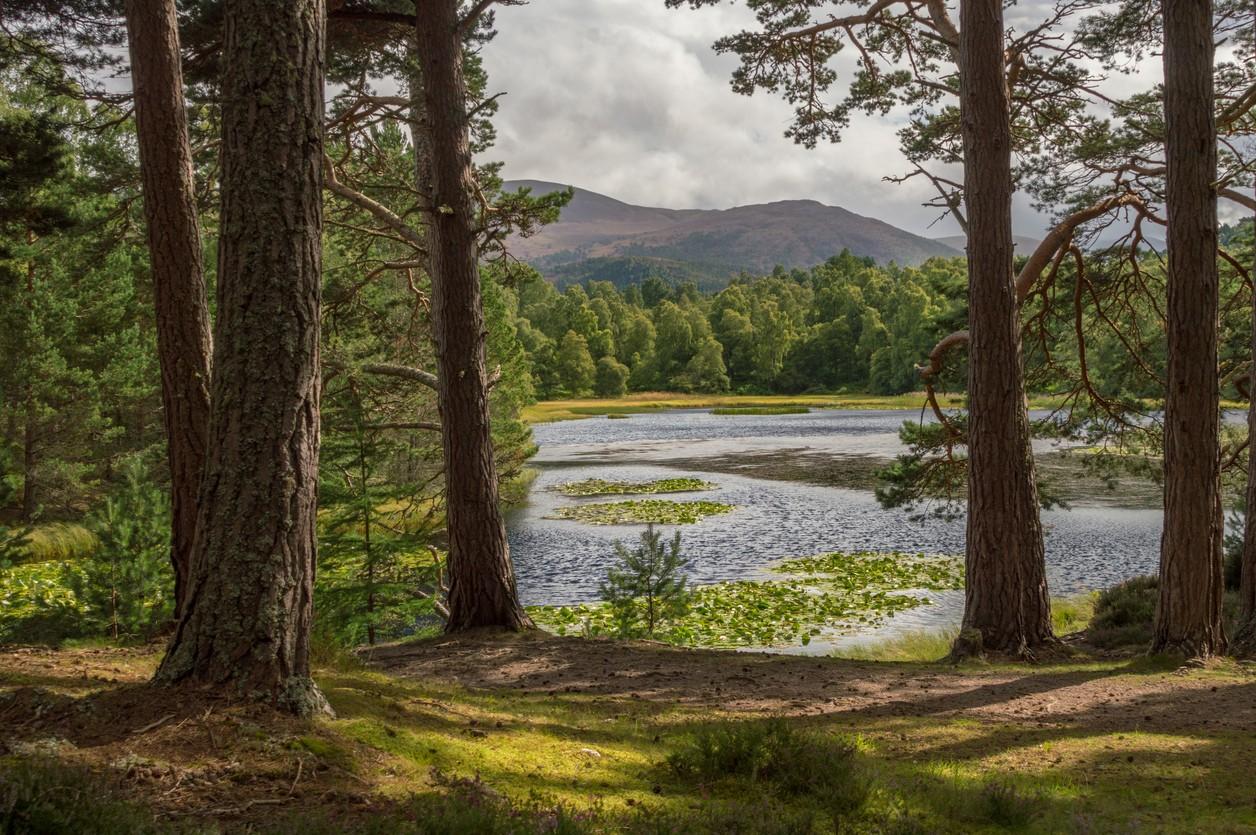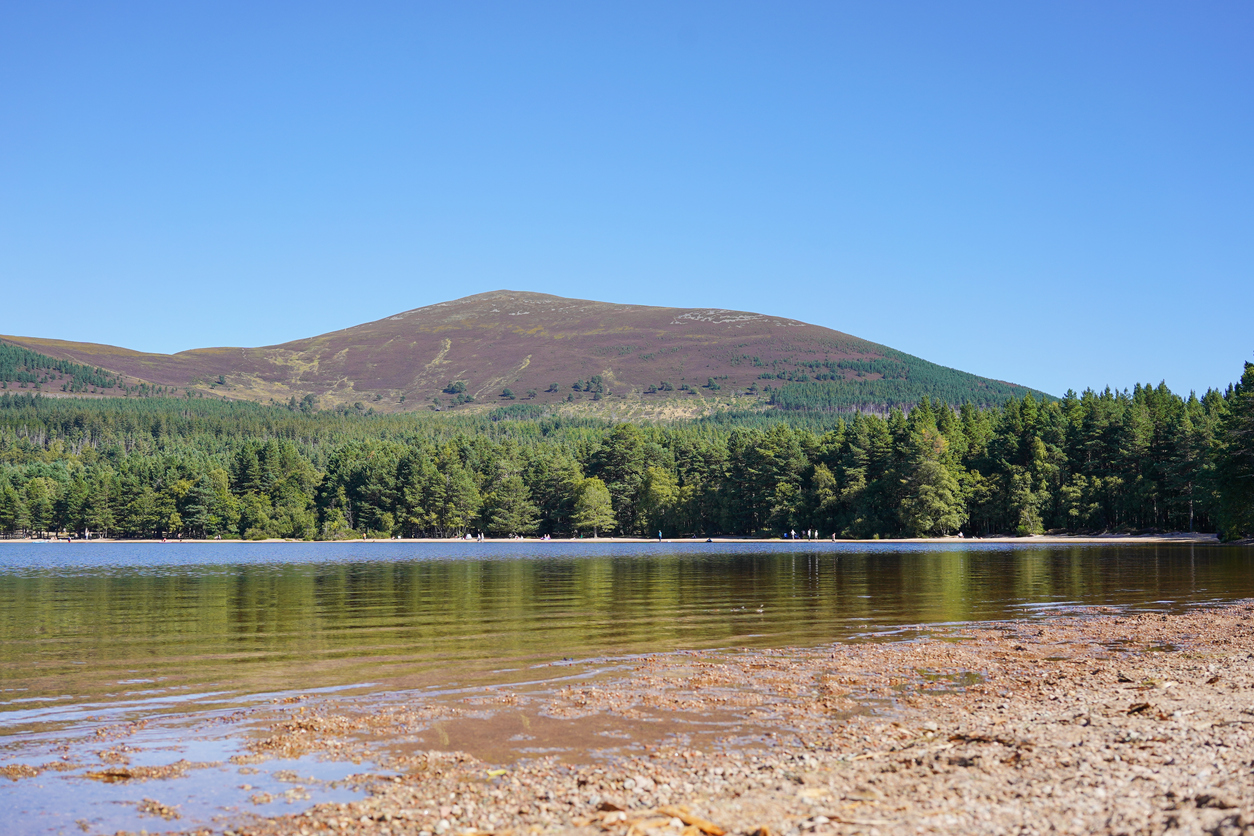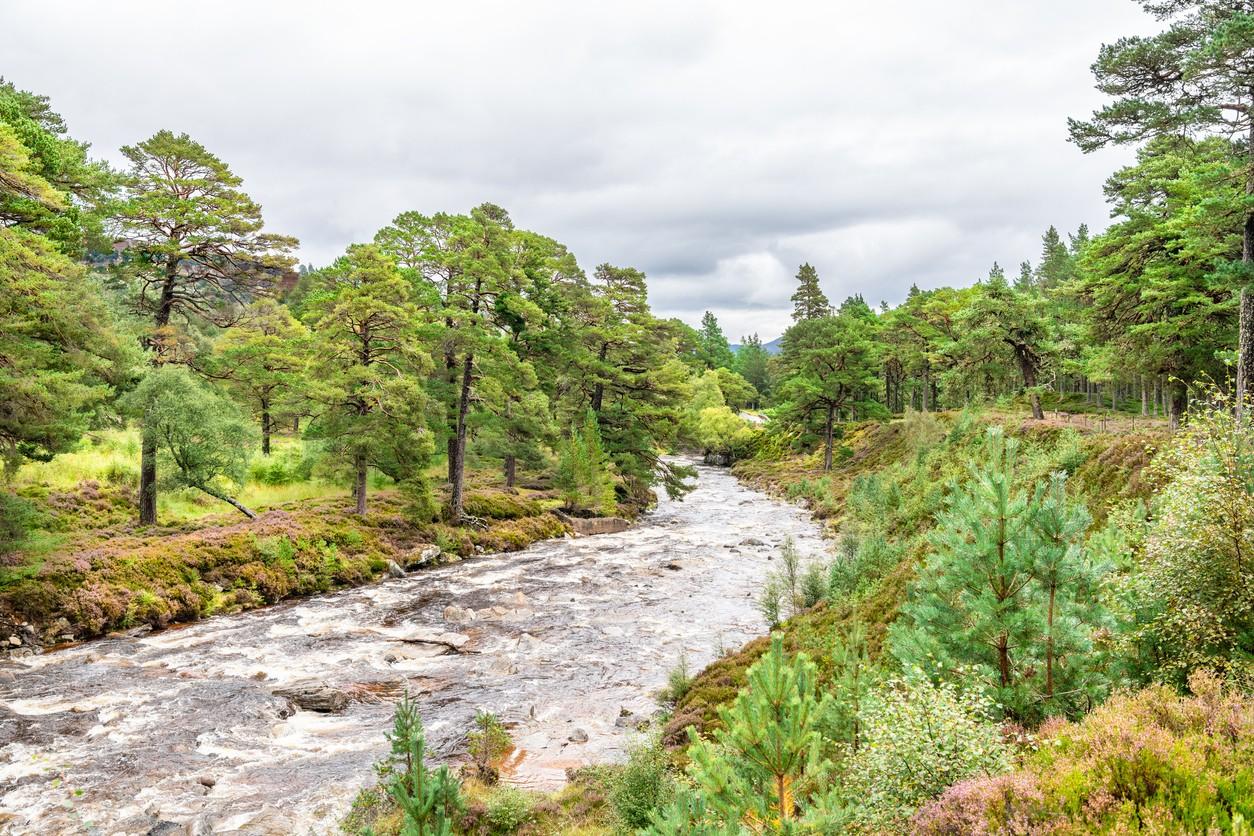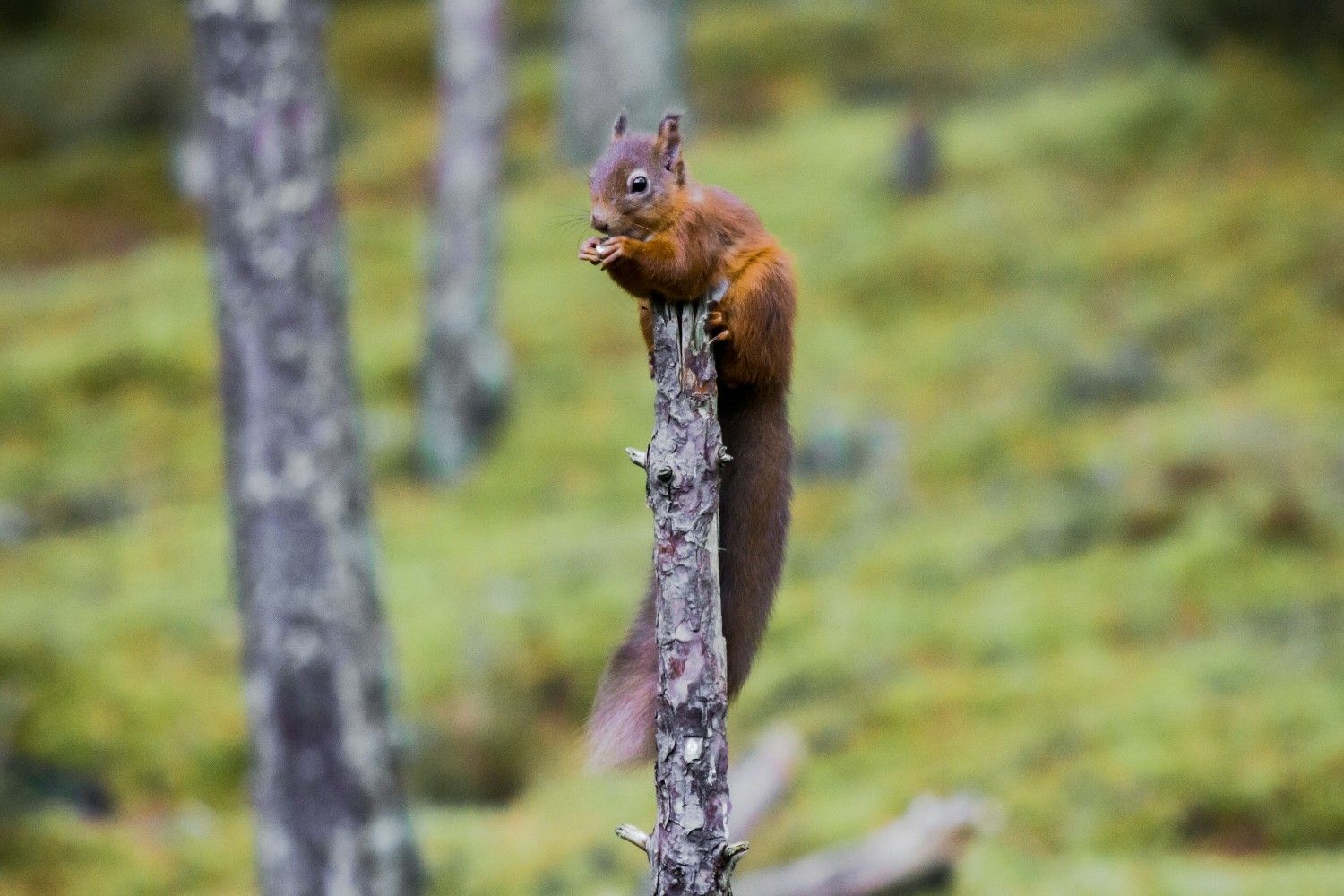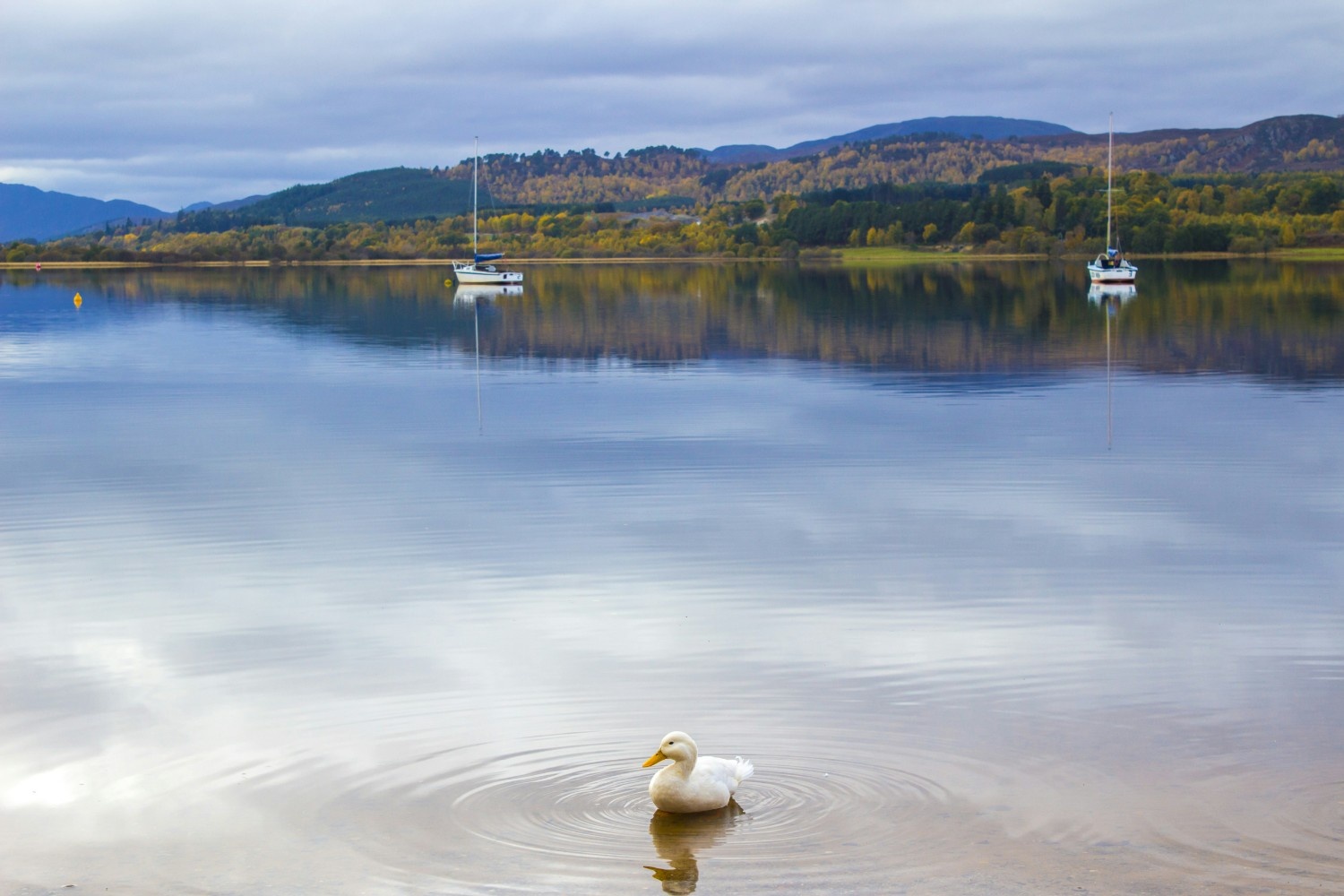The Cairngorms National Park is located in the Eastern Highlands of Scotland, encompassing over 4500 square kilometres of breathtaking scenery. Formally established in 2003, it is home to a wide variety of flora and fauna amidst mountains, forests, lochs, and rivers. The National Park includes parts of Aberdeenshire, Moray, Angus, Perth and Kinross, and Highland. Its protection aims to conserve the special landscapes and habitats, as well as promote sustainable use of its natural resources. Visitors come from across the world to enjoy the spectacular mountain vistas, unique wildlife, recreational activities, local culture and heritage.
At the heart of Cairngorms National Park lie the ancient Caledonian pine forests and arctic-alpine tundra of the Cairngorm mountains. These high and remote peaks offer some of the best mountaineering in Scotland. They are carved from granite bedrock and geologically distinct from other Scottish mountain ranges. Five of Scotland's six highest mountains are found here, including Ben Macdui - the second-highest peak in Britain. The subarctic climate and elevation create an alpine environment home to rare arctic-alpine plants and bird species. Golden eagles, ptarmigan, and dotterel are iconic species found in a few other places in Britain. These mountains contain Europe’s most extensive areas of high tundra plateau.
The park is named after the Cairngorm mountains but also encompasses other important landscapes like Strathspey - renowned for its whisky distilleries, the ancient Scots pine forests of Abernethy and Glenmore, the Dee River valley, and iconic landmarks like Loch an Eilein and Loch Morlich. There are also connections to Queen Victoria, with many local spots mentioned in her diaries. Altogether the diversity of scenery paints an enchanting picture for visitors.
History and Origins of the Park
The origins of Cairngorms National Park stretch back thousands of years into Scotland’s natural and cultural history. People have lived within and around the area now protected for millennia. There is evidence of human habitation since Mesolithic times, following the retreat of the last ice age when tundra and woodlands established themselves. Ancient stone circles and Pictish carved stones hint at the area’s past inhabitants and Early Medieval kingdoms. The landscape inspired literature, art, and folklore through the ages. By the 19th century, it had become established as a destination for adventurers, scientists, sportsmen and royal visitors seeking the wilderness and solitude of the Highlands.
The formation of Cairngorms National Park was first proposed in 1942 to cover the Cairngorm mountains and Strathspey. However, it only gained political momentum in the 1990s through the efforts of conservation groups like the Scottish Campaign for National Parks and the Cairngorms Working Party. There were also parallel moves to protect the Caledonian Forest which once covered much of the Highlands. Public consultation showed strong local support for National Park status to conserve habitats, and cultural heritage and promote sensitive tourism. Finally, in 2003, legislation passed, designating Britain’s largest National Park.
Cairngorms National Park has a complex patchwork of land ownership reflecting Scotland’s social history. Less than one quarter is owned by conservation bodies like RSPB, National Trust for Scotland or Forestry and Land Scotland. The majority lies across private sporting estates owned by individuals or trusts. Deer stalking, grouse shooting and salmon fishing remain important Highland traditions drawing visitors. Balancing these land uses with biodiversity aims has created a lively debate around issues like overgrazing by deer and raptor persecution. Community participation and sustainable development also lie at the National Park’s core. There are hopes it can showcase a greener vision of Scotland’s future where nature, people and local businesses thrive together.
Today Cairngorms National Park attracts over a million visitors per year, drawn by the landscape and nature but also whisky trails, castles, Highland hospitality and the chance to be active outdoors. Looking back across thousands of years, the National Park designation seems like the blink of an eye. But the protected status offers hope that this special place will endure into the deep future, long after our footprints are erased.
Lochs, Rivers and Waterways
From high mountain tops to shaded glens, Cairngorms National Park contains a spectacular wealth of lochs, rivers and waterfalls inviting visitors to explore by boat, bike or boot. Everything from gentle riverside strolls to crashing whitewater awaits. Fishermen cast hopeful lines for salmon and trout whilst paddlers brave frothing rapids. Many waters hold cultural legends about giant kelpies or mystical healing powers. Dippers and wildfowl abound along these azure corridors wending through magical scenery. But threats from climate change and invasive non-native species loom over the future of these glacially-carved blue gems.
Lochs & Rivers
Cairngorms National Park is home to an abundance of magical lochs, rivers and waterways carved from the landscape during recent ice ages, leaving a freshwater heritage still pivotal to local biodiversity, culture and economy today.
River Spey — The River Spey rises inside Cairngorms National Park, forming one of Scotland’s most famous Atlantic salmon rivers. Its clean, clear waters descend through landscapes of ancient pines and whisky distilleries. Beyond its fame for salmon fishing, the Spey offers activities like canoeing and whitewater paddling on sections like the Wave. However, declining salmon numbers and threats from invasive species are conservation concerns.
River Dee — The iconic River Dee flows through the heart of Royal Deeside, Its source lies high in the Cairngorm mountains before meandering past Balmoral Castle and the villages of Braemar and Ballater. Salmon leap up its falls and pools, drawing anglers who admire mountain views lined with Scots pines. Careful management of these fragile river ecosystems aims to balance nature conservation with fishing tourism.
River Don — Rising on the eastern slopes of Cairngorms, the River Don cascades through remote gorges, tracing the border between Aberdeenshire and Donside. Refreshing waters once powered textile mills but now sustain Atlantic salmon runs, otters and rare white-clawed crayfish. Public access allows walkers, kayakers and anglers to experience this lesser-visited river’s secrets.
Loch Morlich — With its golden sandy beaches framed by Caledonian pine forests underneath the summit of Cairngorm, Loch Morlich offers an easily accessible yet quintessential Highland loch experience. Watersports including sailing are popular on warmer days whilst cross-country skiing takes over winter snows. Conservation initiatives protect rare arctic-alpine flora surrounding its shores.
Loch an Eilein — Loch an Eilean’s shallow azure waters reflect scenic vistas of pine, heather and the mouldering island castle. Beloved by Queen Victoria, this tranquil loch circled by paths offers a gateway for exploring Rothiemurchus pinewoods. Careful management balances recreation access with the conservation of sensitive habitats ranging from ancient forests to fen.
Salmon Rivers
The Rivers Spey, Dee and Don all rise inside Cairngorms National Park, forming some of Scotland’s most famous salmon rivers. Hardy fish run the autumn gauntlet of swirling pools and pounding waterfalls to reach quiet gravel spawning beds. Salmon draws fly fishermen from across the world to pit their skills whilst ghillies pass on generations of experience. Bidwells, Carron, Aberlour and many lesser-known tributaries also offer trout fishing in spectacular yet lonely surroundings. However salmon and sea trout numbers keep falling, affected by marine survival, predators like seals and obstacles hampering migration. Catch-and-release rules help conserve fragile stocks. Restoring riverside buffer zones provides shade and insect food sources aiding recovery.
Paddling
Beyond angling, activities like canoe touring, whitewater kayaking, river boarding and pack rafting allow experiencing tumbling Highland burns in exciting ways, however, most watercourses remain the tranquil realms of dipper and grey wagtail. The River Spey draws paddlers seeking its world-class rapids like the infamous Wave. But families also gently meander along the Speyside Way trail using the landmark Boat of Garten bridge as their turnaround point. Canoe trails lead through ancient pines on lochs Morlich and an Eilein whilst packrafters can probe deep into trackless glens. However didymo algae, invasive North American signal crayfish and proposals like hydro schemes threaten fragile aquatic environments.
Conserving Freshwater Habitats
From high mountain tops to shaded glens, Cairngorms National Park contains a spectacular wealth of lochs, rivers and waterfalls inviting visitors to explore by boat, bike or boot. Dippers and wildfowl abound along these azure corridors wending through magical scenery. But threats from climate change and invasive non-native species loom over the future of these glacially-carved blue gems. Strategic planning identifies threatened species and ecosystems guiding targeted efforts around issues like habitat corridors or species translocations. Natural regeneration helps forests transition generationally adapting to new conditions. Restoring peatlands aids carbon storage. International alliances like Transboundary Parks extend shared learning. Overall the park’s size and scientific resources should enable leading demonstrations around sustaining precious freshwater heritage facing pressures.
Iconic Moorland Species
Beyond rare mountain habitats, Cairngorms National Park contains rolling heather moors and grassland supporting iconic Highland species red deer, red grouse and golden eagle. These animals and the land management sustaining their numbers also generate tourism through hunting and wildlife watching. Red deer numbers particularly expanded during the 19th century due to sporting estates. Today 60-70,000 red deer roam the park, more than any other Britain-protected area. Impacts from overgrazing have become controversial yet deer stalking remains culturally important. Grouse moors cover around one-third of the National Park and intensively managed to support red grouse for driven shooting. Raptor persecution incidents highlight conflicts with biodiversity aims. Careful planning balances species, carbon storage in peatlands and community interests.
Red deer range across open moorland, wood pastures and high ground in search of grasses, heather, herbs and tree shoots. During the annual rut, stags roar challenges with clashing antlers. Their russet coats turn grey in winter when they gather in lower valleys. Calves are born very vulnerably in late May. Stalking seasons allow estates to regulate numbers by paying for guns. Venison offers lean organic meat. Some juveniles are caught live for meat or restocking. Deer vehicle collisions and impacts on trees and bird nests can be problematic. Fencing, signs and underpasses help manage road crossings. Culls aim to control grazing effects on other species like capercaillie which need tall heather and pine regeneration. Deer welfare and sporting interests create complex issues around the iconic species most visitors long to spot.
Red grouse occur nowhere else except in Britain and Ireland due to reliance on heather for food and shelter. They’ve declined across much of upland Britain through agricultural changes but remain relatively abundant in parts of Cairngorms National Park. Driven shooting where beaters flush coveys for paying guns earns large sums, funding habitat management benefitting other species too like golden plover, lapwing and curlew. However illegal raptor persecution occurs in seeking to maximise grouse numbers, hampering goals to restore eagles, hen harriers and other natural predators. Broader concerns also challenge intensive management regimes focused on unnaturally high, unsustainable densities to serve bloodsports. More progressive estates demonstrate uplands can balance various interests if given vision and patience.
Diverse Landscapes and Wildlife
Visitors to Cairngorms National Park are greeted by a spectacular variety of scenery encompassing high icy plateaus, ancient forests, crystalline lochs and rushing rivers. This mix of landscapes has created equally diverse habitats for an exceptional range of plants and animals. Exploring the park, you may spot iconic wildlife like red deer, golden eagle, red squirrel, osprey, Scottish wildcat, pine marten, ptarmigan or red grouse. Rare arctic-alpine plants cling to the high tops while lower-down Caledonian pinewoods harbour unique species dependent on these ancient gnarled trees. Both the scenery and nature make lasting impressions for those who take the time to venture out into less crowded corners.
The park’s namesake Cairngorm Mountains contain Britain’s largest area of high-elevation arctic-alpine tundra, found nowhere else in the British Isles. This singular habitat only exists due to the subarctic climate, elevation and aspect. Fierce winds scour snow from wind-blasted plateaus creating a terrain called ‘nieve penitentes’ resembling a frozen sea. In summer, base-rich fens dotted with yellow saxifrage sit amidst a stony grey moonscape. Herds of hardy reindeer-like caribou once roamed here, their traces still frozen in peat. These summits support rare plants like the starry saxifrage and alpine saxifrage along with ptarmigan, snow bunting and dotterel. Few venture to experience the isolation found at over 1000m where only mountain hares and golden eagles are found. But winning views over the ancient pinewood makes the climb rewarding.
Caledonian Forest once cloaked the Highlands after the last ice age but felling and grazing reduced it to 35 small remnants. These Scots pine strongholds contain unique biodiversity including rare wood ants, crested tits, crossbill, capercaillie, red squirrel and Scottish wildcat. Trees like rowan, willow, birch and aspen fill the spaces between pines twisting in strange shapes to escape hungry elk. Beneath lie fields of juicy wild blueberries. Glen Feshie contains some of the most extensive old growth with lichen beards dangling from moss-laden giants. Capercaillie lek here at dawn amongst emerald ferns. But arguably the most majestic Caledonian pinewood lies within Rothiemurchus Estate where strategic tree planting hopes to bridge fragmented sections.
Activities and Attractions
Beyond spectacular mountain vistas and lonely glens, Cairngorms National Park offers lots for visitors seeking adventure, relaxation or cultural connections. Everything from skiing, hiking, biking, sleddog adventures, castle visits and whisky trails can fill itineraries. Quaint villages like Tomintoul - the highest in the Highlands, Ballater, Braemar, Boat of Garten and Kingussie provide hospitality and local services. The park sees over 1.6 million visitors annually, contributing around £150 million to the local economy, however, issues like ‘overtourism’, litter and path erosion come under careful management. Spreading visitors to lesser-known spots protects the environment whilst supporting smaller communities.
For winter visitors, skiing and snowboarding across Cairngorm Mountain draws enthusiasts to granite outcrops offering subarctic conditions. Piste bashers keep over 30 runs open from November to May served by an ingenious funicular railway. Cairngorm rivals European resorts for long, lift-served skiing and stunning views. However, reliance on artificial snow amidst capricious weather and an uncertain climate future raises economic questions. Glenshee, The Lecht and Glencoe hills offer alternative slopes. Off-piste adventures tempt seasoned backcountry skiers. When snow thaws, Cairngorm Mountain becomes a mecca for mountain bikers on natural terrain trails.
Hiking trails lace across the park from multi-day cross-country treks like the Speyside Way to hour-long forest wanders. Steep paths test fitness on iconic mountains like Ben Macdui or Lochnagar whilst riverside trails meander past distilleries. Year-round options range from wide forestry tracks to faint hill paths requiring navigation skills. All visitors should prepare responsibly checking weather, gear and route conditions to avoid costly rescues. Path erosion sees popular routes hardened or upgraded. Citizen science projects enhance access like ‘Tracks for the Future’ restoring lost paths. Keeping dogs on leads protects livestock and ground-nesting birds. Initiatives highlight less crowded spaces relieving pressure on honeypot sites.
Related articles

Let us know you agree to cookies
We use marketing, analytical and functional cookies as well as similar technologies to give you the best experience. Third parties, including social media platforms, often place tracking cookies on our site to show you personalised adverts outside of our website.
We store your cookie preferences for two years and you can edit your preferences via ‘manage cookies’ or through the cookie policy at the bottom of every page. For more information, please see our cookie policy.
